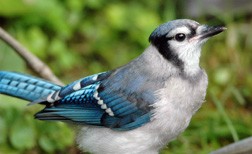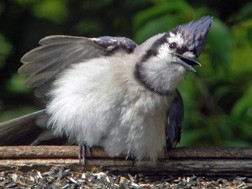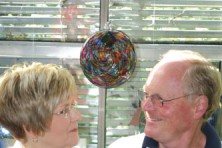Blue Jay
- Share
- Tweet
- Pin
- Share
Ask enough people, especially those who feed birds, what their feelings are toward the Blue Jay and answers will vary considerably. I would guess that close to as many like this flashy bird as those who don’t. Surely their descriptions would include some of the following: bossy, colorful, boisterous, inquisitive, cunning, handsome perky crest, noisy and strident, mischievous, adds life to the otherwise dull winter woods, as intelligent as a crow, corn thief, hog at the feeders, and robs eggs and/or young at other birds’ nests.
Regarding the Jay’s reputation of being a nest robber, I’m convinced that John Audubon’s famous “elephant portfolio” of bird paintings, including the one of Blue Jays stealing eggs from another bird’s nest, convinced people unquestioningly that these birds were absolutely no good. In order to prove a point, professional ornithologists, having a federal permit, killed 530 Blue Jays and, in checking the stomach contents, found that only six had egg remains in them.

This immature Blue Jay has few black bars in the blue of the greater covert wing feathers.
At the beginning of the 20th century, agriculture experts studied 292 Blue Jays killed in various parts of eastern United States in order to determine their economic value, and found that the remains of songbirds were found in only two stomachs and small birds’ egg shells in three. For the most part the Jay’s stomachs contained acorns, beechnuts, corn, and pine seeds, as well as beetles, grasshoppers and caterpillars.
Before my hearing began to deteriorate about 30 years ago, I became very interested in the songs and call-notes of birds frequently used by me and fellow birders in locating and identifying the birds. I don’t think there is another species native to our part of the state that has a wider assortment of vocalizations than the Blue Jay. Perhaps most people recognize the bird’s alarm call, a loud noisy “JAY JAY JAY!” A chorus of a half-dozen or more Jays is known to simultaneously shriek in concert at the very sight of a hunter.
I especially like some of its strange calls, including, “WEEDLE WEEDLE,” or “TEE-kle TEE-kle,” sounding a little like “TEA kettle, TEA kettle.” Some field guides actually include the bird’s “tea kettle’ song in its description. It would be fun to learn why the Jays use these calls. Another of my favorites is its “rusty pump handle” song, one that I’ve enjoyed a number of times especially when we lived at the Ridges and had so many Jays coming to our feeders and entertaining us.
The bird really stretches upward as it pumps out this rusty and friendly call. Could those little “blue hogs” do away with a lot of sunflower seeds! In the case that you have these flashy birds coming to your feeders, take the time to count the number of seeds one can stuff into its gullet before flying away to cache them for future use. You’re in for a surprise.

A side view of an adult Blue Jay shows the intricate black barring in the wings.
It was more than 50 years ago that I read the excellent book Wild America, the story about the adventures and travels on the North American continent of the great Roger Tory Peterson and his famous British ornithologist friend James Fisher. At the end of their year together in North America, Fisher made the statement, something to the effect, that the most beautiful bird he had come to enjoy during the year being together with Peterson was none other than the Blue Jay.
This reminded me of an experience Charlotte and I had during March of 1976 while visiting the Sunset Crater National Monument northeast of Flagstaff, Ariz. We were about to walk up the stairway to the Nature Center when we were suddenly entertained by our first ever, most gorgeous Steller’s Jay, close relative to our Blue Jay. The ranger appeared surprised at our admiration of that stunning dark-crested Jay and commented, “Oh them. They’re regular pests!” Later we wondered what his reaction would have been upon sighting his first Blue Jay in our area.
Years ago, when I was a federally licensed bird bander, I greatly enjoyed demonstrating banding to people of all ages, especially school-aged children. My favorite bird for capturing, banding and showing to students came to be the Blue Jay. It is large, strong, and quite docile in the hand and can easily withstand being held for a few minutes before being released.
One of the things I did was hold the bird on its back and blow firmly on the belly. The feathers part and if the bird is a female, an extraordinarily large brood or incubation patch, minus feathers, will extend practically from their lower throat area to the base of the tail.
A wonderful revelation came about when I asked the students what color the Jay was. Obviously it’s blue, that is until I extended one of the bird’s wings and held the bird, its colorful-appearing back facing the students, above my head so that the creature was between the sun and the class. Suddenly the blue color disappeared as though by magic and was replaced by a dull gray. “You mean to say that a Blue Jay isn’t blue?” they’d ask. My reply was, “That’s correct and neither is a Bluebird nor an Indigo Bunting.” When the light bounces off the Jay and is reflected back to your eyes, as a result of the feather structure and interaction, it only makes them appear to be blue.
You should have seen the look of surprise that came from the kids’ eyes when they saw that the bird’s knee joint is actually concealed under the belly feathers, and that what they always thought was the knee is really the bird’s ankle. The same generally holds true for all birds. Yes, they have very long foot bones.

Blue Jays go into a virtual trance when they sun bathe.
Another point I asked the students was: “You use an umbrella or raincoat to stay dry when you have to be outdoors during a rain storm. How about the birds? What keeps them dry?” The first response usually was stony silence. That was a pretty tough question. Answers ranged from staying in their nest to hiding under the leaves of a tree, or maybe they went into a big cavity in an old rotten tree.
Finally someone remembered that birds oil their feathers, so I’d ask, “Do they buy a can of 3-in-1 oil at the hardware store?” It so happens that the majority of birds have what is referred to as an oil, preen or uropygial gland situated on the top of their rump. By blowing firmly on the Jay’s lower backside, along with a little help from my fingers, the feathers parted nicely. This revealed a tiny, light yellow, wart-like gland that the bird will squeeze with its beak to obtain oil with which to swipe onto, to groom and to waterproof its feathers. Surely you’ve seen swallows perched on an overhead wire at the approach of a rainstorm, picking at their rumps and getting oil from their oil glands.
Blue Jays are fascinating birds in many ways, even though their feathers really aren’t blue.

